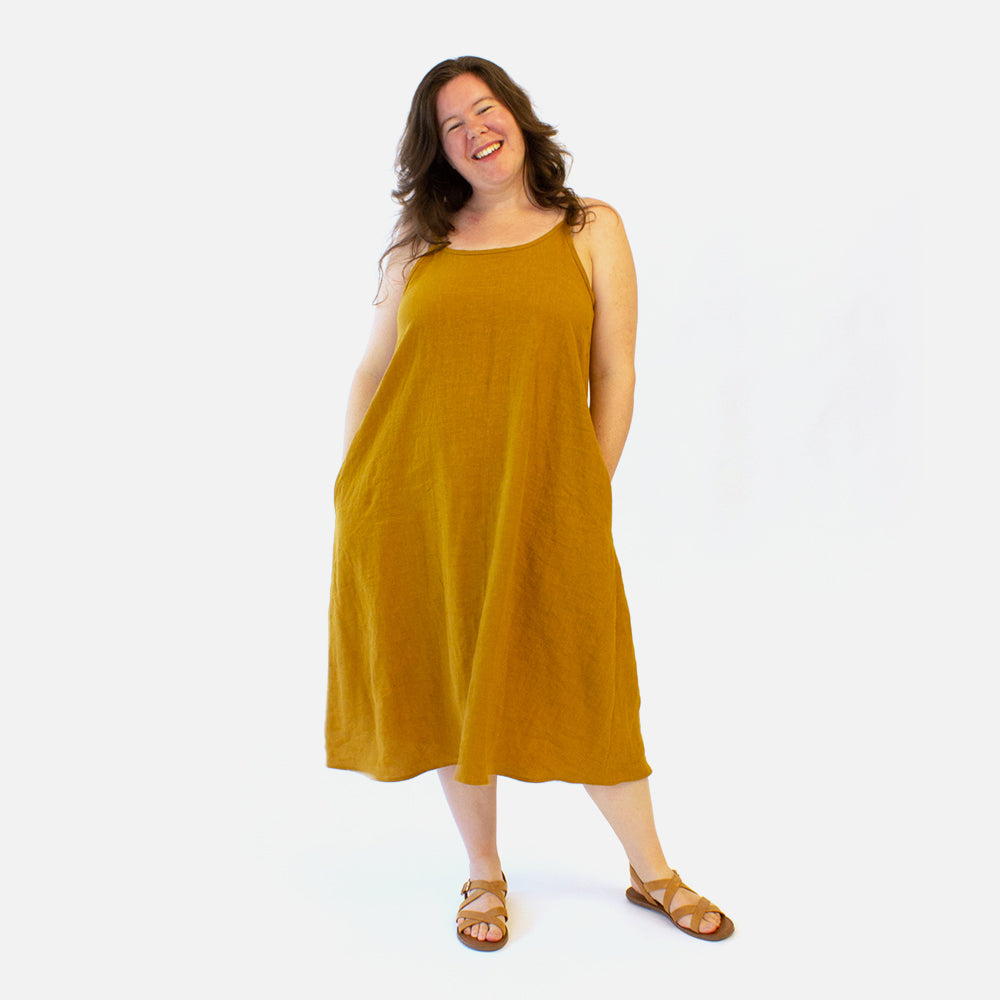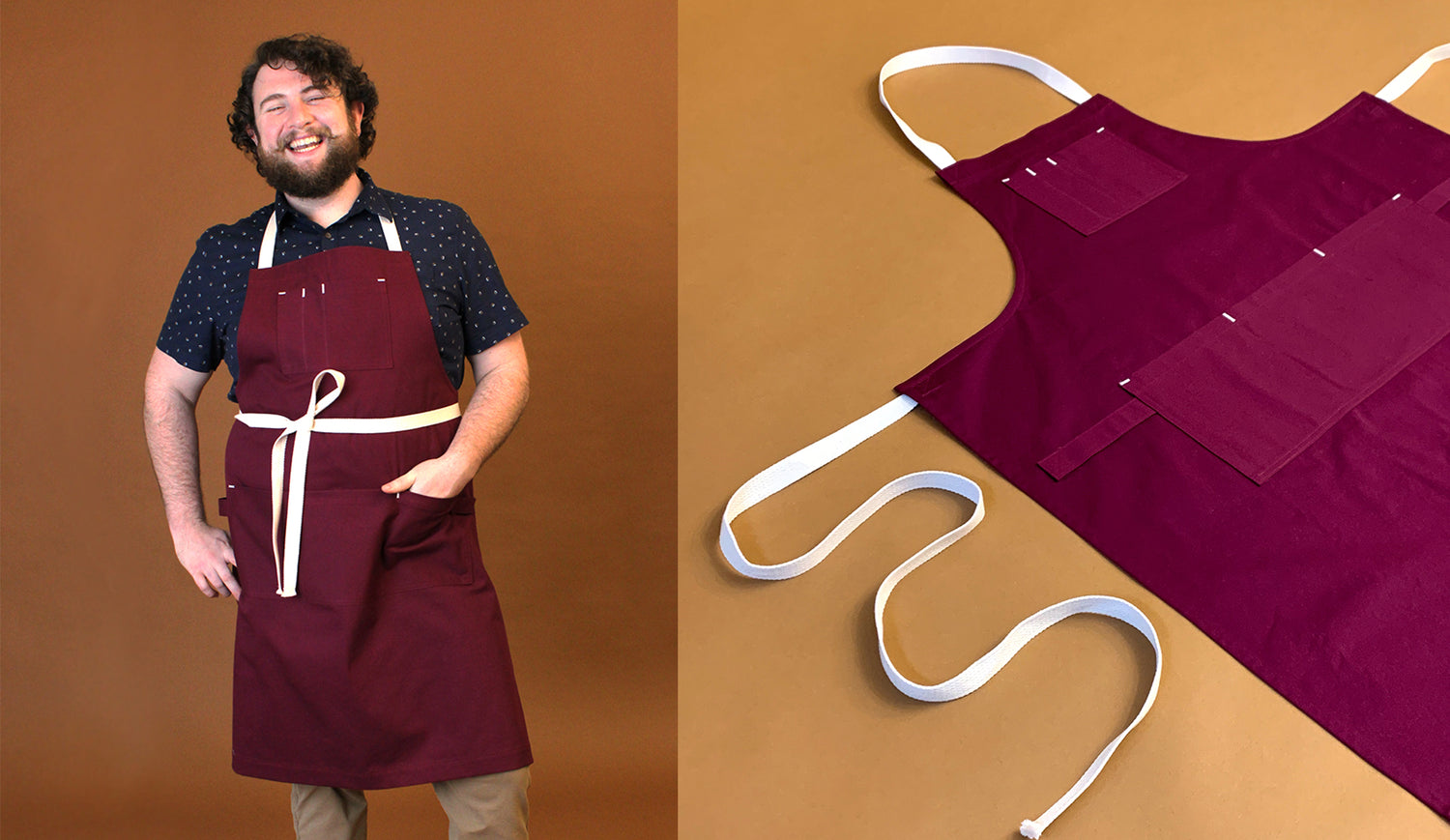 Choosing a Suitable Fabric
Perhaps the hardest part of sewing is picking the right fabric! It is simultaneously fun and stressful, as you try not to get distracted by all the beautiful things out there that won't work for your project. The key to sewing success is the right fabric, and I have learned over the years to choose carefully and buy the best quality I can afford. Because I like to invest in my fabric, I will often make a test version (muslin or toile) to check the fit. With pants this is generally a good idea, because fitting a crotch seam can require some adjustments. The Winslows have a very loose fit and a dropped crotch seam, so you may decide to just go for it, which is OK too!
Choosing a Suitable Fabric
Perhaps the hardest part of sewing is picking the right fabric! It is simultaneously fun and stressful, as you try not to get distracted by all the beautiful things out there that won't work for your project. The key to sewing success is the right fabric, and I have learned over the years to choose carefully and buy the best quality I can afford. Because I like to invest in my fabric, I will often make a test version (muslin or toile) to check the fit. With pants this is generally a good idea, because fitting a crotch seam can require some adjustments. The Winslows have a very loose fit and a dropped crotch seam, so you may decide to just go for it, which is OK too!
 Recommended Fabrics
The Winslow Culottes work best in light to medium weight woven fabrics with plenty of drape such as rayon challis, viscose poplin, crepe dé chine, silk charmeuse, lightweight wool, linen, tencel, chambray, and cotton twill. View A and B work well with both fluid and slightly structured fabrics. For the longer lengths (view C and D), a lighter weight fabric with plenty of drape is strongly recommended.
I cannot stress enough how crucial drape is for this design. If you decide to go with a stiff fabric for views C or D, you will feel as though you have your legs in two stiff cones - not a great look. Don’t fear though, there is a range of drapey-ness (is that a word?) that is suitable, check out the comparison between my very lightweight crepe de chine versions below on the left and Sara’s more structured cotton Winslows on the right.
Recommended Fabrics
The Winslow Culottes work best in light to medium weight woven fabrics with plenty of drape such as rayon challis, viscose poplin, crepe dé chine, silk charmeuse, lightweight wool, linen, tencel, chambray, and cotton twill. View A and B work well with both fluid and slightly structured fabrics. For the longer lengths (view C and D), a lighter weight fabric with plenty of drape is strongly recommended.
I cannot stress enough how crucial drape is for this design. If you decide to go with a stiff fabric for views C or D, you will feel as though you have your legs in two stiff cones - not a great look. Don’t fear though, there is a range of drapey-ness (is that a word?) that is suitable, check out the comparison between my very lightweight crepe de chine versions below on the left and Sara’s more structured cotton Winslows on the right.
 See how her pleats are holding their shape while mine are more fluid? If you are interested in the skirt illusion, a very lightweight fabric with a lot of drape will contribute to this effect.
For the shorter versions (A and B), a lightweight cotton will work, as the shorts can be a bit more structured and still be comfortable to wear. The version on the left below is made from cotton, see how it sticks out a bit at the sides? In a more drapey fabric, the sides will be more straight and the overall effect will be more swingy, like my tencel version on the right.
See how her pleats are holding their shape while mine are more fluid? If you are interested in the skirt illusion, a very lightweight fabric with a lot of drape will contribute to this effect.
For the shorter versions (A and B), a lightweight cotton will work, as the shorts can be a bit more structured and still be comfortable to wear. The version on the left below is made from cotton, see how it sticks out a bit at the sides? In a more drapey fabric, the sides will be more straight and the overall effect will be more swingy, like my tencel version on the right.
 If you live in a cooler climate, you may be wondering how to make the winslows work for you. Choose a lightweight wool with a nice drape for the perfect autumn pants, or make a shorter version in a more structured twill and pair them with tights and boots. I cannot wait for fall so I can try out some winter Winslow looks. Check out this great version by Emily from In The Folds.
If you live in a cooler climate, you may be wondering how to make the winslows work for you. Choose a lightweight wool with a nice drape for the perfect autumn pants, or make a shorter version in a more structured twill and pair them with tights and boots. I cannot wait for fall so I can try out some winter Winslow looks. Check out this great version by Emily from In The Folds.
 Solids or Stripes?
That is the question, isn’t it? Thankfully, you can go either way with this pattern! The Winslow Culottes have a straight side and hem seam, so a stripe, plaid, or other repeating pattern won’t be distorted. If you're feeling adventurous, go all out and try a border print! I love working with prints, so I designed the Winslows to pair nicely with repeating patterns.
Solids or Stripes?
That is the question, isn’t it? Thankfully, you can go either way with this pattern! The Winslow Culottes have a straight side and hem seam, so a stripe, plaid, or other repeating pattern won’t be distorted. If you're feeling adventurous, go all out and try a border print! I love working with prints, so I designed the Winslows to pair nicely with repeating patterns.
 My Fabric Wishlist
I could honestly go for more Winslow's, even though I have 6 in my closet already! I just love the way they look and feel, they really suit my lifestyle perfectly. Here are some fabrics I’ve been eyeing for my next pair(s). I actually already have that shibori border print in the upper right corner and I am planning an awesome Winslow jumpsuit hack - stay tuned.
My Fabric Wishlist
I could honestly go for more Winslow's, even though I have 6 in my closet already! I just love the way they look and feel, they really suit my lifestyle perfectly. Here are some fabrics I’ve been eyeing for my next pair(s). I actually already have that shibori border print in the upper right corner and I am planning an awesome Winslow jumpsuit hack - stay tuned.
 Row 1: Black Tencel Twill, Pineapple Rayon, Shibori Border Print
Row 2: Coral Rayon Challis, Tropical Rayon Voile, Geometric Poly Crepe
Row 3: Abstract Dots Challis, Light Blue Linen, Floral Rayon
Choosing an Interfacing
Row 1: Black Tencel Twill, Pineapple Rayon, Shibori Border Print
Row 2: Coral Rayon Challis, Tropical Rayon Voile, Geometric Poly Crepe
Row 3: Abstract Dots Challis, Light Blue Linen, Floral Rayon
Choosing an Interfacing
A woven interfacing with no stretch in the lengthwise direction is needed. Choose an interfacing that is a slightly lighter weight than your fabric. A fusible interfacing is easiest, but sew-in will work as well. There are so many different types of interfacing, the best way to familiarize yourself with different kinds is to try them! As long as you choose something that is the correct wight and does not have stretch in the lengthwise direction, you will be good to go.
Zipper Options The Winslow Culottes are finished using an invisible zipper at the center back seam. This method provides a clean finish, where you can barely tell a zipper is there at all! Some people prefer lapped zips, and the good news is, you can swap out the zip in this pattern thanks to the wide seam allowance (⅝” or 1.6cm). Meg from Cookin’ and Craftin’ did this with her version. Another option would be an exposed zip, you can make a bold statement with a bright colour or metal teeth. We will be doing an invisible zip in this sewalong. Don’t let a zip scare you. If you are beginner it can be a challenge, but once you have done one, a whole world of sewing will be open to you! You can practice on some scrap fabric to get the process right first. Getting Ready To Sew
Once you have purchased your fabric, be sure to pre-wash it to ensure you don’t end up with a final garment that shrinks in the wash. Yes, this step is very important! I like to throw my fabrics in the washer AND the dryer once, and then I hang my me-made garments to dry, In the event that a me-made does end up in the dryer by mistake, there is none to minimal shrinkage because I ran it through the dryer that first time.
Tomorrow we will be printing and putting together our PDF patterns, so get your scissors and tape ready for that! I hope this post on gathering supplies has been helpful, Please let me know if you have any questions!
Getting Ready To Sew
Once you have purchased your fabric, be sure to pre-wash it to ensure you don’t end up with a final garment that shrinks in the wash. Yes, this step is very important! I like to throw my fabrics in the washer AND the dryer once, and then I hang my me-made garments to dry, In the event that a me-made does end up in the dryer by mistake, there is none to minimal shrinkage because I ran it through the dryer that first time.
Tomorrow we will be printing and putting together our PDF patterns, so get your scissors and tape ready for that! I hope this post on gathering supplies has been helpful, Please let me know if you have any questions!






